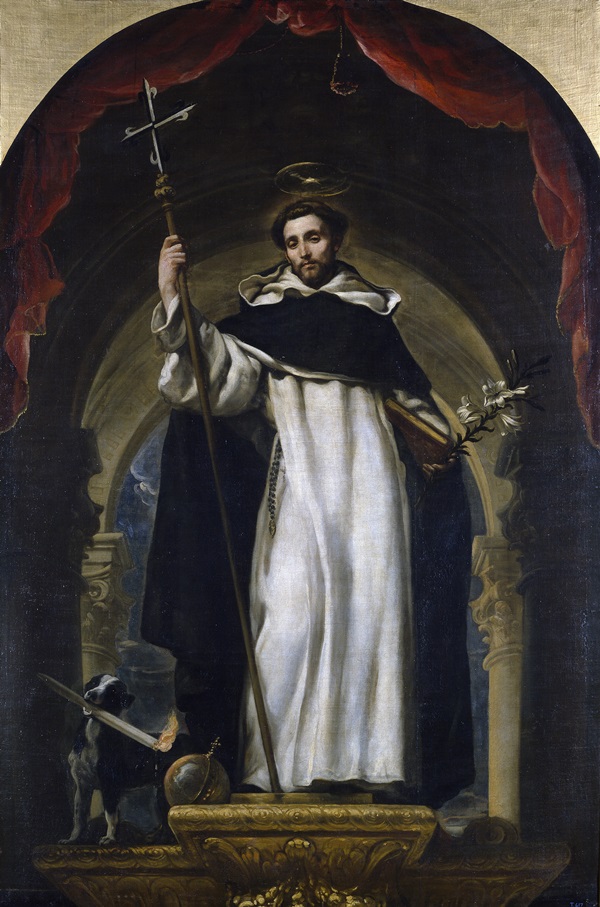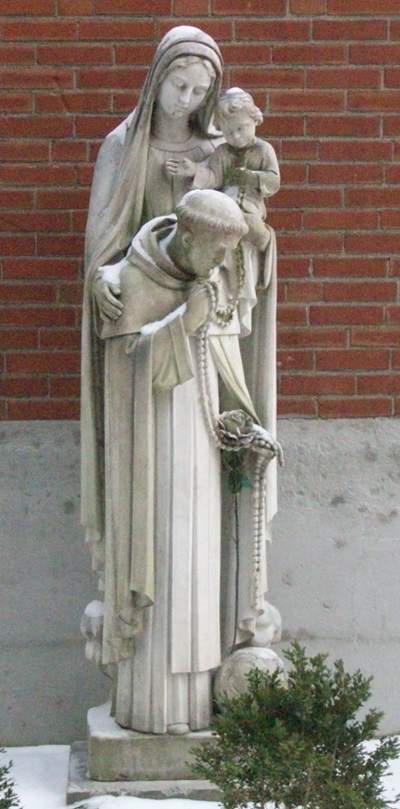A Dominican Parents’ Dilemma

Santo Domingo de Guzman by Claudio Coello, oil on canvas, c. 1685
Regular readers are quite aware by now that our oldest son is a student brother of The Order of Preachers, the Catholic religious order more commonly known as The Dominicans. As Catholic parents, Mrs. JPC and I have become more keenly interested in the Dominicans than we ever were before. And when one dives into an the world of the Dominicans, one is led into some study of the life of St. Dominic as well.
I have written previously on St. Dominic and on the Dominicans’ approach to the Catholic faith, one that is both cerebral and evangelistic. I have fought my way through one biography of Dominic that was fairly difficult reading due to being translated from another language and being perhaps too scholarly for my purpose. Note to self – just because it comes in paperback doesn’t make it an easy read. There has been, though, one problem that I did not foresee: we can’t find a decent sized statue of St. Dominic anywhere.
We Catholics love our statutes. There was a time when we were accused of worshiping them, but that was back in the day when Catholic churches were full of statutes and full of parishioners who sat, stood and knelt to a liturgy in latin, all of which made Catholic worship appear as a cult-like experience to those who might have peeked inside. But today, when the Mass is in English and where people in shorts and sports jerseys attend a church full of banners, those charges of statue worship seem oh so nineteenth century.
Properly understood, a statue can serve as a reminder of a holy person from the past, someone who lived life in a way that can inspire us live our own lives better than we often do. In this respect, religious statues are no different from the pictures of deceased loved ones that we display on a shelf in our family room. Statues of saints come in plastic, plaster, concrete and even in metals. They are cast, sculpted, painted or plain, and come in a variety of sizes, from teeny ones that can stick on the dashboard of your grandmother’s Buick or big ones that stand three feet high in the garden. And when your son is a Dominican, it certainly can’t hurt to see a daily reminder of Dominic, who by all accounts led a life of heroic sanctity.
So, in review, we have a well-known saint who started a really big religious Order that remains a vital part of the faith today. Yet we can’t find a statute? You cannot go to a place that sells “Catholic Stuff” (a term that will not be found in the Catechism, but which is a “thing” nonetheless) or a place that sells concrete outdoor statuary without tripping all over depictions of Mary and St. Francis. But Dominic? Fuhgeddiboutit. Even in this, the 800th year from the founding of the Dominican friars, Dominic seems to be a man with no popular following, at least among people who buy garden statues.
Statues of Mary, I get. She kind of stands a rank above the other saints, and for obvious reasons – I mean, who wouldn’t love Jesus’ Mom!. We have a concrete depiction of Mary in our own backyard, who serves as a gentle reminder of how we should strive to live. However, the weather has been taking its toll on our concrete Mary, and the Mrs. is keen to find a replacement.
But St. Francis, that is something else. St. Francis really shouldn’t irritate me, but I must confess that he does, if only a little. Actually, it is not St. Francis who irritates me, but the huge popularity of St. Francis in popular culture. Ahhh yes, St. Francis: Lover of nature, gentle soul who speaks to the birds, peaceful man who is like a magnet to all of the gentle animals of the meadow and forest. Plainly an environmentalist of the first order, was Francis – at least in the popular mind. I fear that St. Francis has become co-opted by the the modern world in the same way that St. Patrick has been.
In truth, St. Francis was ardent in his love of Christ and his spreading of the Gospel during the middle ages. I wonder how much of his fan base knows that he began as a soldier and wanted nothing more than to rid the world of Islam (although by evangelization and not a sword). Dominic was just as devoted and zealous, but he is not found near every middle-aged woman’s garden birdbath. Could Francis have had a P.R. firm? Or else the reputation of being so in tune with nature is just always going to be more popular than countering ancient heresies.

For a moment, we thought our problem had a solution when we saw the statue outside of the Dominican Priory in St. Louis. As a bonus, Mary and the infant Jesus come as part of the package! While it stood significantly taller than I do, surely the company that supplied it would also offer smaller versions suitable for a backyard garden. But it turned out to be an original piece of statuary carved by, you know, a real artist. So no luck there, because no matter how much I might want St. Dominic’s depiction gracing my lawn, I am not about to become a patron of some artist in order to get one.
You might think that in this age of the internet, my problems would be over. But no – I can find a smattering of figurines suitable for a bookshelf or large works of art that sell for four figures. And nothing in between.
As I think about it, how would I actually know that a statue actually depicts Dominic and not some other friar of his era? Perhaps I can make this work to my advantage. Would it be out of line to paint the distinctive black and white habit on a St. Francis statue? This would probably not be a good idea because I would likely have to chisel off a bird or a rabbit while I’m working on it. I guess there is nothing to do but keep looking. But perhaps meanwhile, I can buy some time on our old Mary statue by giving her a good scrubbing and maybe a coat of some sealant to keep the moisture out of her pores.
Mary . . . water . . . suddenly I have a taste for a glass of wine.

The reason for St. Francis statues is, I assume, one that my mother could answer. She knows about all those weird things that Catholics have done for ages and now they just do them because their parents did them and their parents were their examples for faith. Kind of like burying a statue of St. Joseph at a property you want to sell. I’m sure it’s been justified to some degree. That would explain the proliferation of small statuettes of St. Joseph.
I have a completely unsubstantiated theory to pose: back in the day when gardens weren’t things people made to look nice, but things people used to grow food that they could eat, you would put a statue of St. Francis in your garden (or in your field, if you were a legit farmer) so that the animals wouldn’t eat all the food. That would make a lot of sense, with Francis being the patron saint of animals.
LikeLike
An interesting theory, and I have no idea whether it has basis or not, as I know very little about St. Francis. But he sure has a following, whatever the reason.
LikeLike
The entrepreneurial Dominican could tool up for a mid-sized statue, make one for themselves and sell a few others to pay for the tooling and make a few bucks at the same time.
Won’t be me though, not only can I not even spell entrepreneurial without spellcheck, the Calvinists threw that (statue of a) baby out with the bathwater.
LikeLike
HaHaHa, I had actually thought of this idea. The only thing stopping me is a complete lack of talent for sculpture or for working with concrete. And if I got past those hurdles, I could imagine being stuck with three dozen of them that nobody else wants. It is so much easier to just kvetch into a keyboard.
LikeLike
Very interesting! I like to put little statues of angels in my yard. It would be really cool to have a great statue of Jesus.
LikeLike
Pingback: Celebrating Advent – With Spray Paint | J. P.'s Blog